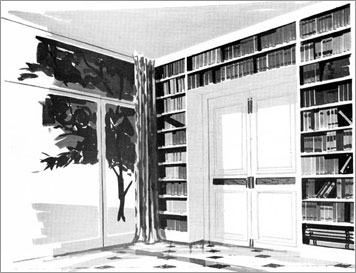
65 Ways to Decorate with Books in Your Home, 1956, illustrator unknown
When ink on paper finally goes the way of the Dodo (or the eight track), as certain dodos have predicted, heaps of printed papers will remain on earth. So the question will be what to do with what's left? Ray Bradbury suggests in his 1953 dystopian science-fiction novel, Fahrenheit 451, that incineration is an option, but in truth the looming paper redundancy does not demand such hot draconian measures. When every bit of recorded human knowledge is digitized and available through Google or Jeeves alternative uses must be found for untold metric tons of paper, and particularly all those pesky books. So what is needed is the repurposing of these venerable materials into useful life-enhancing goods. Any suggestions?
Even before the advent of the digital information revolution, books were overshadowed by the specter of forced obsolescence. What does one do after reading the latest bestseller? Give or throw it away? Ultimately, books (read or not) end up on someone's shelf somewhere, perhaps never to be handled again (other than to periodically dust them), which is reason enough to find new ways to imaginatively reuse them. So back in 1956, The New York Times promotion department provided a viable answer in the form of its The New York Times Shows You 65 Ways to Decorate with Books in Your Home, a book/zine with a reasonable $1 cover price. (I recently uncovered this lost document when the Times moved to its new headquarters.)
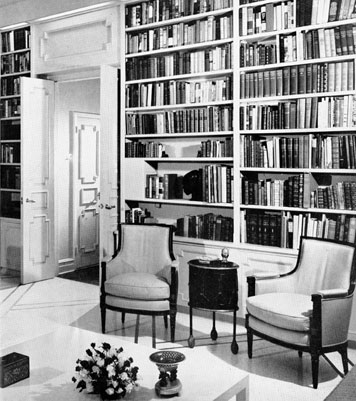
65 Ways to Decorate with Books in Your Home, 1956, photographer unknown
"There was a time, not so very long ago," wrote Betty Pepis, author of interior decoration books, in the introduction to 65 Ways to Decorate, "when books had little to do with the decorating of a home. Banished from the front parlor or the formal living room, they were confined to a den or a library reserved for the purpose... But homes have changed a great deal in the past two decades. Space is tighter. The front parlor is often the only parlor... So it has happened that books, of necessity, have become an inevitable part of the contemporary all-purpose living room... Integrating the library pleasantly into the home décor is a challenge that architects, designers and decorators have had to solve."
Indeed, in those heady golden days before most new-fangled apartment kitchens became stand-alone islands in living rooms, bedrooms were considerably larger than walk-in closets, and den/libraries were not called "home offices," books were ghettoized in their own "serious kind of place." The average apartment in 1956 was no longer spacious, and as Pepis rightly noted, designers were forced to view books as necessary components of their overall design schemes — if only to find ways to fit them into the home. Although covers and jackets were never originally designed to dress up an environment "recognizing that vividly colored bindings of the modern book can be utilized effectively as a positive decorating asset" had become a territorial imperative. Hats off to modernity.
"Books today are well dressed," added Pepis. "Gone, fortunately are the gloomy dull-covered tomes of earlier times [the ones that now command high prices on Ebay], forbidding and heavy in appearance." In their place, friendly brightly-colored covers and jackets often with ornamental motifs on the spines made an "effective and pretty picture when used to decorate a whole wall."
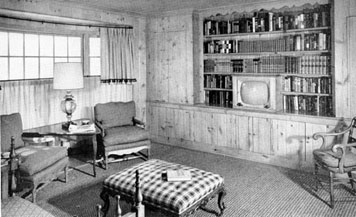
65 Ways to Decorate with Books in Your Home, 1956, photographer unknown
Separate libraries (a luxury in most average homes) gave way to the idea of bringing books as ornamental fixtures "out into the open" and this has, as Pepis proclaimed, "created new respect for their existence — books share shelf space with the most precious works and objects of art — in recognition of the fact that all these moments of living collectively produce the individual personality of a room by reflecting the interest of its inhabitants." Furthermore, since the basic form of the book had not changed in hundreds of years, most quotidian books exude a sense of timelessness that works just as well in Victorian, Art Deco or ultra Modern environments, and with Danish Modern, Nouveau Siamese or English Country furniture. Here, for example, is how the reader was told that books add dimension to the modernistic home of a famous art collector: "The asymmetric placement [of the books] enhances the owner's Dufy water color and provides space of other objects." And the chapter "Tie in With Traditional Formal Décor" addresses how, "French provincial pine paneling... frames books in a formal authentic period living room."
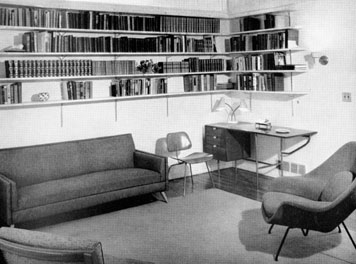
65 Ways to Decorate with Books in Your Home, 1956, photographer unknown
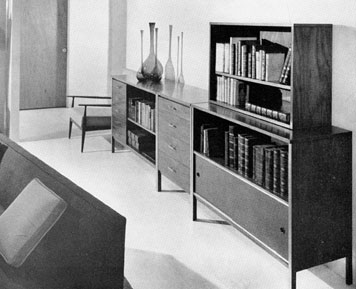
65 Ways to Decorate with Books in Your Home, 1956, photographer unknown
Incidentally, if you think that book décor is the last resort of mediocre designers, think again. In 65 Ways to Decorate, examples of bookdecor include rooms designed by Eliot Noyes, George Nelson, Philip Johnson, Gio Ponti, Henriette Granville and Melanie Kahane (married to pioneer news anchor and typophile, Ben Grauer).
Once these and other respected designers liberated books from being mere vessels of words into what Pepis calls "respected objects of design," they also found that books provided functionality that the original scribes and printers could never have dreamed. In addition to chapters in 65 Ways to Decorate on specific decorative applications, including "Capitalize on Corners," "Be intelligent in Foyers," "Seasonal Supplements for Patios" and "Reading Matters in the Bedroom," books proved to be excellent sound and heat insulation, supports for tables and breakfronts, as well as pedestals, doorstops and other household accruements (though never as coasters).
If the past (51 years to be exact) foretells the future, there is hope on the horizon for books. Just as Ray Bradbury's "firemen" in Fahrenheit 451 were the ones who incinerated books, maybe "book designer" will be a synonym for an interior decorator who uses books to enhance the environment. Such, I suspect, is the essence of today's multiplatform design integration.
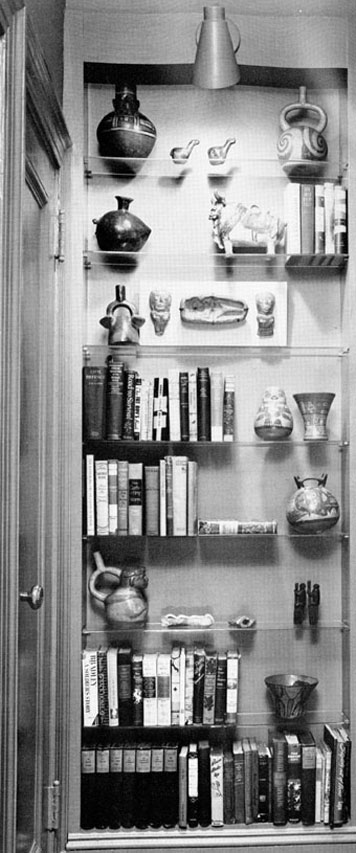
65 Ways to Decorate with Books in Your Home, 1956, photographer unknown


Comments [30]
a good bookshelf and collection makes a house feel a little bit more friendlier and comfortable. especially when you have a good mix of the old and new, soft and hard cover books.
oh, and nicest bookshelf has got to be the 4th image down
09.26.07
07:33
09.26.07
08:35
09.26.07
09:22
I discovered another surprising asset. Like most modern interiors, the house has hard surfaces, no window treatments, etc., making it potentially much too live and reverberant for the sound system. And its size makes reverberation even more threatening. In fact, though, the place is magnificent for sound, and not soo blurry. Why?, I ask myself. I am now sure that the wall of books saves the day. Books don't absorb sound, like heavy curtains, but they diffuse it -- send it off in small bits in myriad directions so it never reassembles. Lovely.
09.26.07
10:29
There is something about books that nurtures the soul like digital media can never do. Although the contents of large libraries can fit on a couple of DVDs, the experience of being physically surrounded by so much knowledge and effort is exciting to me. The one thing I miss in digital media (and I've been a digital media designer for 14 years now) is the touch and feel of paper - the tangibility and tactileness (is that a word?) of the media.
Oh, and (IMHO) typesetting for print is like conducting a symphony. Web typography? Baboons with kazoos. But I do it anyway. Ooh ooh ooh...
09.26.07
10:55
All the typophiles, and designers, and book junkies will buy them up. That's what'll happen. I can't wait!
09.26.07
11:13
Personally, I stack my books to build walls. Walls that protect me from ignorance.
09.26.07
11:13
This is a great quote, one for history, but the fact is that it, in all its weight, will be stored and referenced here, not over there on the bookshelf.
This writer became so involved in the stacking of his books that he couldn't see the forest for the trees; he did not realize that books will eventually come to pass here.
09.26.07
12:10
I'm sorry, but that just misses the point! Bookcases should start off empty and be slowly filled over the years with books that you've read.
A person who won't read has no advantage over one who can't read. - Mark Twain
09.26.07
02:02
09.26.07
02:19
A couple years back, being the poor man in a rich man's neighborhood, I was invited to the unveiling of a recently renovated apartment. This particular Master of the Universe surrounded himself with exquisite furniture, beautiful wall surfaces, unique finishes and several hundred books.
As is the trend, his designer had made a materials spec sheet available. The only thing missing from the list was that he had obviously made use of the Strand Bookstore's Books by the Foot service.
You may find amusement in the fact that many, many of the books were either written or edited by you. None of the spines were cracked and none exhibited any kind of wear whatsoever.
09.26.07
03:21
09.26.07
04:07
Or, to answer the original post, perhaps all those Reader's Digest Condensed Books and Sue Grafton novels and such can somehow be pulped, literally, to provide blow-in insulation for highly-insulated green buildings!
09.26.07
04:40
http://www.newyorker.com/talk/2007/10/01/071001ta_talk_kelley
09.26.07
04:43
09.26.07
05:00
09.26.07
05:18
09.26.07
09:02
VR/
ps. For Marian: Bookends GALORE! Ha!
09.27.07
12:57
That was just one of many things I miss. There was also a similar hidden panel to the right that covered video surveillance of the building entrance and an intercom system. There was also another door on the inside of the room that lead to an upstairs deck with a small swimming pool, plus a huge set of windows looking out on the ranch. The swimming pool was actually mounted on I-beams and there was parking on the ground level beneath it.
I only subconsciously thought of it while there, but reading Kingsley's comment reminds me that back in the day I was Master of the Universe. Oh well, the view from the old horse I ride today is much better anyway.
09.27.07
10:29
09.27.07
01:27
Reading a book or magazine is an activity that permits the participant to retire from the active world and lose themselves in a piece of literature. It is an activity allowing for total comfort and seclusion, be it under a heavy blanket in the dead of winter or stretched out on a sunny patio.
I take pride in my small but growing library, but also enjoy using old case-bound books found at estate sales and thrift stores to decorate the rooms of my apartment. They add a certain homey quality to the room and make for interesting conversation as visitors spot some rather intriguing titles, like the Modern Marine Engineer's Manual right next to an old Pilgrim Hymnal.
Books are beautiful.
09.27.07
01:39
Their slip-free bottom surface keeps things from going haywire, they slide under the last few books to use their weight as an anchor, and their slim profile doesn't try to be anything other than it is.
09.27.07
02:05
09.27.07
02:29
As for living rooms : too public a space, for so personal a picture.
Would that I could afford rooms enough, to afford a room without books.
Nicholson Baker took the books used as props in a haberdashery as the theme for an essay, I fuzzily recall.
As for decorative color schemes, I prefer the more sober spines of an earlier time, that hold up well to sunlight, handling and other insults.
09.28.07
05:24
We should never displace function with aesthetic. So lets read the books that line our wall of decor and even share them with our neighbor that comes to visit, instead of leaving them dusty and only to impress the visitor with what we haven't read. Function and aesthetic is the solution for this article.
10.01.07
12:03
We should never displace function with aesthetic. So lets read the books that line our wall of decor and even share them with our neighbor that comes to visit, instead of leaving them dusty and only to impress the visitor with what we haven't read. Function and aesthetic is the solution for this article.
10.01.07
12:32
I have find that if I'm in a home or a room and their aren't any books -- that it will be the first thing I notice. And I'll always comment about it after I leave.
10.04.07
06:34
http://www.typography.com/ask/showBlog.php?blogID=25
10.06.07
07:03
Yes, recycling is a GREAT idea, but, not everyone does it or has the facilities to do so. But, at the end of the above article, it mentions how books are a nice insulator: this leads me to the idea of reusing old materials. So, instead of insulating walls with insulation, why not use old books? I mean, if someone has the resources to fill entire walls with books they will never read, why not put them INSIDE the walls. Sure, one may miss out on the impressive aesthetic beauties of the books lined on shelves, but why double insulate, right? Seriously. Think about this... What if a new library wants to be a green library? Why not use old books to insulate the walls of that library. Now that would give the community something to talk about!
The chatter about reusing books rather than burning them (Fahrenheit 451) can be applied to all facets of used materials in the design world. I mean, isn't it true that the majority of our landfills are filled with paper products? Hmmmm. This reminds me of the architect who uses old materials to build new and fascinating homes for people... some homes for free, some for the very rich. I really wish I could think of his name right now, but he also built a church structure from basically nothing but old tires. Talk about resourceful.
Basically, I feel that more awareness should be brought to the issues of reusing and recycling materials, rather than how impressive someone's unused bookshelf may be... And I think that was the inspiration of this writing.
10.09.07
02:51
Alas, books may not be up to the task.
They are vulnerable to mildew and bookworms, and probably to dry rot. They might be suited to some climes, and not to others. And then there's the Fahrenheit 451 factor — they may not satisfy the fire retardant requirements of contemporary building codes.
Orhan Pamuk's recent Other Colors: Essays and a Story has several chapters about books per se, including "How I Got Rid of Some of My Books." (An earthquake made him do it.)
10.09.07
09:12